
Official Edgar Rice Burroughs Tribute and Weekly Webzine Site Since 1996 ~ Over 15,000 Webpages in Archive |

Official Edgar Rice Burroughs Tribute and Weekly Webzine Site Since 1996 ~ Over 15,000 Webpages in Archive |
![[Cover of Fantomen 4/1999.]](erbcover.jpg) |
Edgar Rice Burroughs' famous immortal
literary characters
have become the heroes of a very long and successful line of comic
adaptations.
Tarzan has been one of the longest-running (and arguably one of the
best)
newspaper strips ever, not to mention countless comic book stories.
Other
characters, not least Korak, John Carter and Carson of Venus, have
become
fan favourites in their own stories.
Their creator had the habit of inserting himself as a literary character in his own books. Yet, to the best of my knowledge, the character Edgar Rice Burroughs never made an appearance in any of the comics. That is, not until a few years ago. In 1999, Edgar Rice Burroughs appeared in a comic story, possibly for the first time ever. But surprisingly it was not in a story featuring one of his own heroes, but in a story with The Phantom. |
I suppose most people are at least superficially familiar with The Phantom. As a comic character he has a history, which is not quite as long but in some respects even more successful than Tarzan's.To Tarzan fans, The Phantom has long been known as "the other jungle strip," quite unfairly since it is in no way plagiarized, owing more to Zorro than to Tarzan. It started as a newspaper strip in 1936, created and written by Lee Falk, who was to continue writing it until his death in 1999. The first artist was Ray Moore, who was later succeeded by Wilson McCoy. The real boom in popularity came when Sy Barry took over as artist in the early 60's, and he stayed on the strip until 1995.
The Phantom became a popular character all over the world, and especially in two markets outside the United States. Those two markets were (and still are) Australia and Scandinavia. The popularity in Scandinavia has resulted in a very strong Swedish licence production of comic book stories with The Phantom ever since the early 60's. This production is still on-going.
| Especially popular in the Swedish production
are stories
from "The Phantom's chronicles," i.e. stories from the past featuring
one
of The Phantom's many forefathers. It was in one of these stories, the
26 pages long "Lord of the Jungle", that Edgar Rice Burroughs appeared.
Plot by Kjell T. Johnsen, script by Claes Reimerthi, art by Heiner Bade
(incorrectly credited to Carlos Cruz in the original Swedish
publication)
and painted cover by Rolf Gohs.
"Lord of the Jungle" was first published in the Swedish Fantomen comic book, issue 4/1999 (which also contains a very good introductory article about Burroughs). It has since been published at least twice in English, namely in Australian The Phantom #1225 (Frew) and in Indian The Phantom #7 (Egmont Imagination India). |
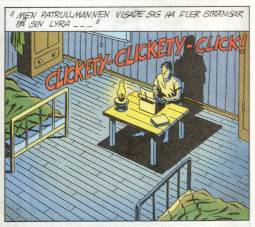
Young author at work in "Lord of the Jungle." |
Summary
Warning: If you intend to read the story yourself, this summary can spoil some of your fun. You may want to skip it for now.The Phantom reads a story from the chronicles to his wife Diana. The story was written down by his great grandfather, the 18th Phantom, and the events took place in the year 1899.
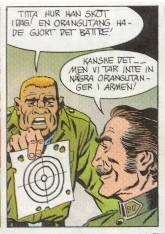
Sgt. O'Rourke complains about Edgar's shooting. |
The young recruit Edgar has been accepted to the Jungle Patrol (a para-military jungle police recruiting from all over the world of which The Phantom is the secret commander) not because he passed the very high requirements for patrolmen, but because the colonel likes the short stories he writes. Edgar's sergeant, O'Rourke, is constantly on his back, bullying him for the slightest fault. Yet when the Jungle Patrol is going to escort an expedition to find a legendary figure called The Phantom (even the Jungle Patrol does not know that their secret commander is aught more than a legend), both the sergeant and Edgar are assigned to the escorting patrol. Through secret channels, The Phantom is informed about the expedition and its target and decides to keep an eye on it, since he "cannot well allow them to succeed." When he sees the expedition heading for the territory of the wild Wasaka tribe he is starting to become worried. |
| After the expedition has made a camp for the night, Edgar is sent out to fetch water and accidentally discovers The Phantom in the process of taking a swim. Edgar is attacked by a crocodile and rescued by The Phantom who kills the animal with his knife. The Phantom leaves the unconscious Edgar who is later found by his fellow patrolmen, but they have made a mistake in leaving the camp unguarded and when they return they find the expedition's leader, professor Digmore, gravely wounded by an arrow and his two assistants disappeared. O'Rourke, violating normal procedures, orders Edgar to remain and guard the professor while he and the rest of the group return to headquarters for reinforcements. | 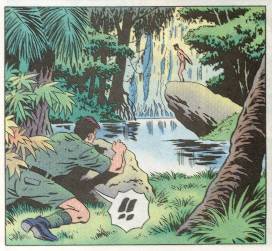
A rare example of The Phantom without his mask and tights |
The Phantom joins the couple left behind and sends his trained chimpanzee to fetch his friends in the Bandar tribe. After they have arrived to take care of the professor, Edgar and The Phantom go to the Wasaka village. There they rescue the two assistants, who have been tied to poles and are about to be sacrificed. The Phantom then follows them to the nearest part of civilization after having given Edgar the medallion of his "good mark" along with his mailing address.Back in the present our current Phantom has finished his story and takes Diana to the treasure room to show one of the great treasures there: a mint copy of the first Tarzan story in The All-Story magazine, which Edgar Rice Burroughs sent to his forefather as thanks for the help and the inspiration.
Review
| "Lord of the Jungle" is not a very great
story by any
standards, but it is not very bad either. The art looks a little tired
and uninspired, although technically there is not much wrong with it.
The
artist has a good grip on the character of The Phantom, but the other
characters
look cartoonish, almost deformed, at times. The surrounding jungle is
nicely
done, however, and the very Tarzanesque cover by Gohs (with a history
of
more than 800 The Phantom covers!) is very neat.
The script, like the art, shows few technical flaws, but is still very far from being a literary masterpiece. Except for the inclusion of Edgar Rice Burroughs, the story is not very original and the characterizations are weak. Especially the sergeant is just your everyday bully sergeant that has been seen so many times before (and usually better portrayed) in comics, books and especially movies. |
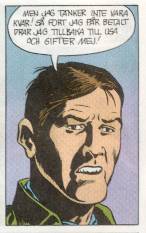
E. R. Burroughs, as portrayed by Bade. |
As for the handling of Burroughs' character I cannot really say that I have an opinion, other than I doubt the real Edgar was quite so intimidated and clumsy. Yet, the action is well paced and the dialogue flows naturally, as you would expect from a seasoned pro like Reimerthi.In short, "Lord of the Jungle" should have its natural place in the collection of every fanatic Burroughs comic collector. But if you are looking for a great comic experience, then you should perhaps look elsewhere. There are so many better comics to be discovered, both with The Phantom and with Burroughs' many creations.
![[The Phantom proudlyshows his copy of The All-Story.]](erb6.jpg)
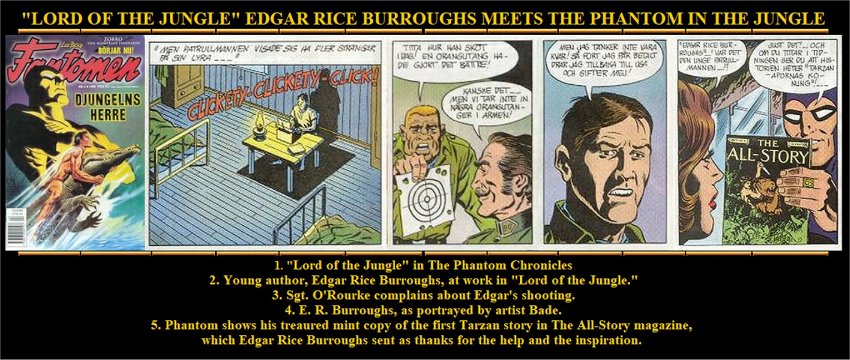
![]()
![]()
Volume
0853

WEBJED:
BILL HILLMAN
Visit
our thousands of other sites at:
BILL
and SUE-ON HILLMAN ECLECTIC STUDIO
All
ERB Images© and Tarzan® are Copyright ERB, Inc.- All Rights
Reserved.
All
Original Work © 1996-2011/2024 by Bill Hillman and/or Contributing
Authors/Owners
No
part of this web site may be reproduced without permission from the
respective
owners.